
Welcome back to the “How to” series on pitching, where we will be diving into various pitches and speak about different grips, cues, tips, movement profiles, and even a top MLB comparison for reference when looking at a given pitch. Next up, how to throw a changeup.
Change Up Overview
The changeup is an off-speed pitch that pitchers can use deceptively off their fastball to disrupt a hitters timing at the plate. Generally speaking, the changeup will have some degree of “drop” or “run” to a pitcher’s arm side. In addition, the changeup will typically be around 6-12 mph slower than the pitcher’s fastball. This differential in speed and the similarity in release to a fastball is what causes the timing disruption to the hitter. This could lead to the hitter being off balanced during the swing, resulting in a positive outcome for the pitcher.

Desired Movement Profile
Before we talk about the tips and tricks on how to throw a better slider, let’s continue to discuss how we want this pitch to move.
The desired movement profile for the changeup depends on which type of fastball you will be playing it off of. For someone who primarily throws 2SFB/Sinker, you will want your changeup to possess more “run”. For a pitcher who primarily throws 4SFB, you will want your changeup to possess more “drop”. The reason for this is because it will be easier to tunnel the two pitches when they have similar movement out of the pitchers release into decent towards the plate (we will discuss this more in-depth later in this article).
For a changeup that desires more “run”:
-
- You will want to apply more sidespin to the baseball. The sidespin is what causes the pitch to move horizontally towards the pitcher’s arm side. On this changeup pitch, we ideally want to limit the amount of vertical movement and capitalize on the amount of horizontal movement we can achieve to the pitcher’s arm side. This is a similar movement pattern to what we would look for in a pitchers 2SFB/Sinker. Typically we look for anywhere from 10-15+ inches of run on this type of change up.
For a changeup that desires more “drop” (to play off a pitcher’s 4SFB):
-
- On this pitch, we essentially would like the pitch to have similar metrics to the 4SFB but with a drop in (+) vertical break and velocity. For example, if a RHP pitcher has a 4SFB that plays at 85 MPH with +17 VB and +5 HB – with a changeup that plays at 78 MPH with +10VB and +5HB… this change in vertical break and velocity would be ideal when trying to tunnel these two pitches and create deception when trying to fool hitters.
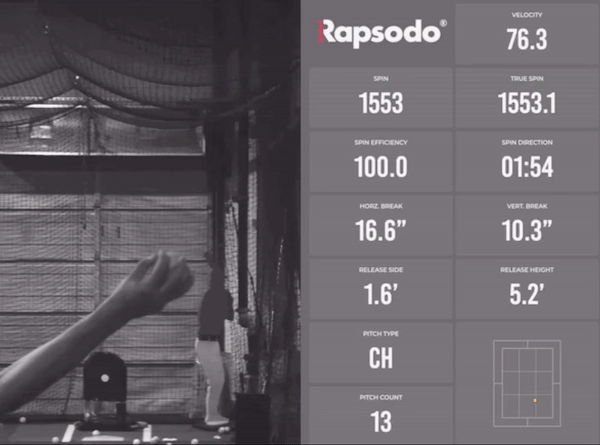
Ideal Changeup Location on a Movement Chart
A movement chart is a tool that players and coaches can use to analyze the ideal movement and placement of a given pitch.
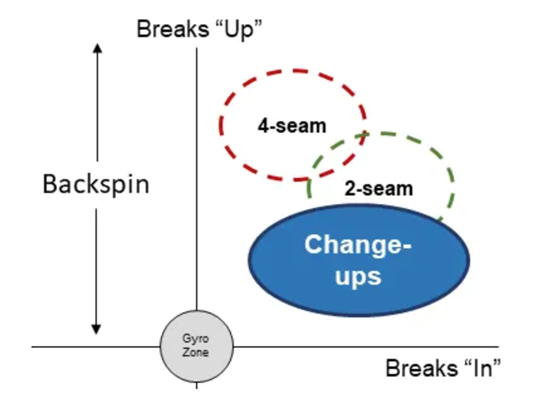
What each zone represents:
-
- The grey circle in the center of the chart represents the “gyro zone” which is a pitch with no movement in either the vertical or horizontal plane.
- The upper right quadrant (image above) represents positive vertical movement and positive horizontal movement.
- The upper left-hand quadrant represents positive vertical movement and negative horizontal movement.
- The lower right-hand quadrant represents negative vertical movement and positive horizontal movement.
- The lower left-hand quadrant represents negative vertical movement and negative horizontal movement.
The chart pictured above is representative of a right-handed pitcher’s ideal placement for each pitch. A changeup is a pitch you want to “drop”, or “ride” out of the pitcher’s hand. This means it will have positive horizontal break towards the pitcher’s arm side. This puts the upper right-hand quadrant as the most ideal for right-handed changeups.
For lefties, the vertical drop would stay the same. But the horizontal movement that would be desired would have negative value. Therefore, making the upper left-hand quadrant the most ideal for a left-handed changeups.
Interested in learning more about remote programs, you can simply click below to schedule a phone call.
Changeup Grips
How to throw a changeup often comes down to the grip. When gripping the changeup, there are typically 3 different variations that we try with our athletes…
Grip #1 – Traditional Changeup Grip
We usually have athletes orient this grip similar to a 2SFB, with their middle and ring ringers pressed up on the seams. The index finger and pinky will be off to the side, not touching any seams. And lastly, the thumb will be underneath the baseball for more control.
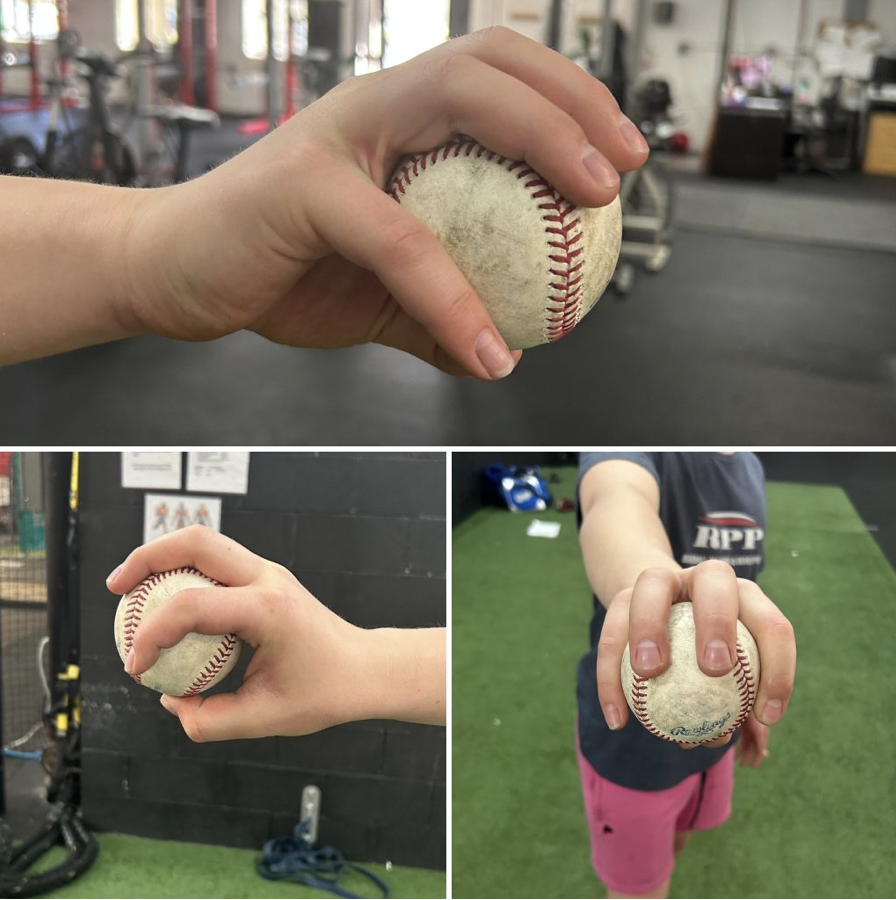
Traditional Changeup Grip
Grip #2 – Circle Changeup Grip
For the circle changeup grip, the biggest stand out is obviously… “the circle” on the side of the ball. The athlete will make a circle with their index finger and thumb on the side of the baseball, while having their other 3 fingers loosely holding onto the top of the baseball. This pitch may not be the best recommendation for younger athletes, as their hands might not be big enough to hold this grip and control it as they need too.
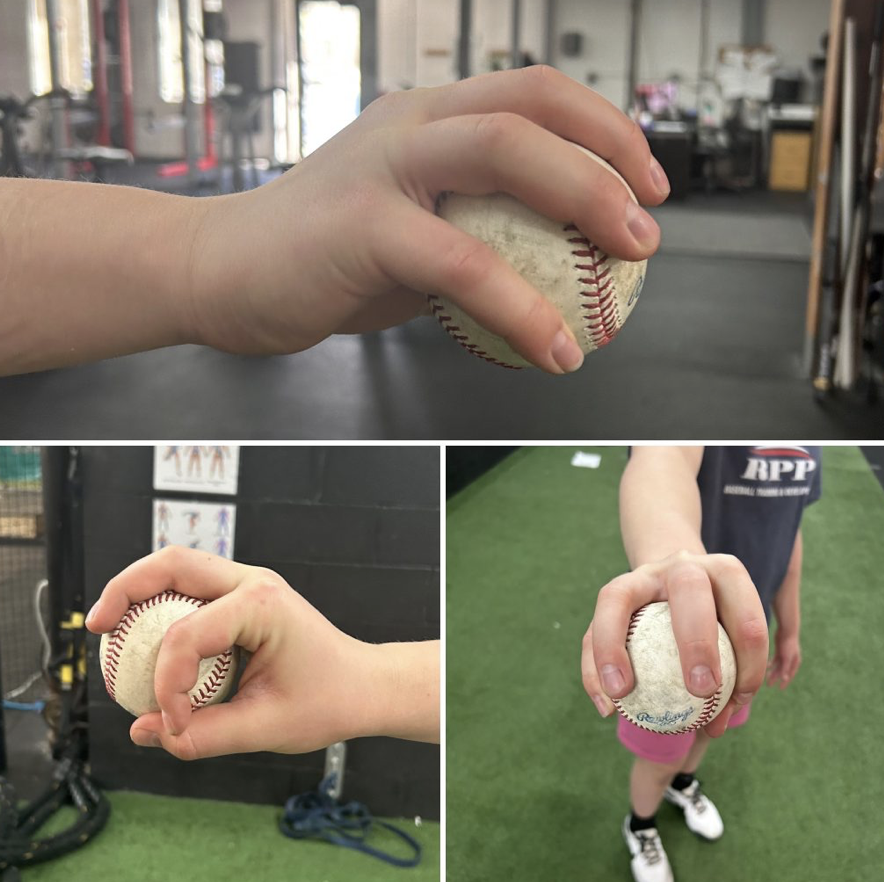
Circle Changeup Grip
Grip #3 – Split Changeup Grip
For the split changeup grip, the athlete will spread their index and middle fingers slightly outside the 2SFB grip. The ring, and pinky, fingers will be off to the side with the thumb on the bottom. This grip is recommended for athletes who can’t grasp the feel or release of a standard or circle changeup grip. It gives the athlete a more “fastball feel”, but the slightly split fingers allow for a similar drop in velocity.
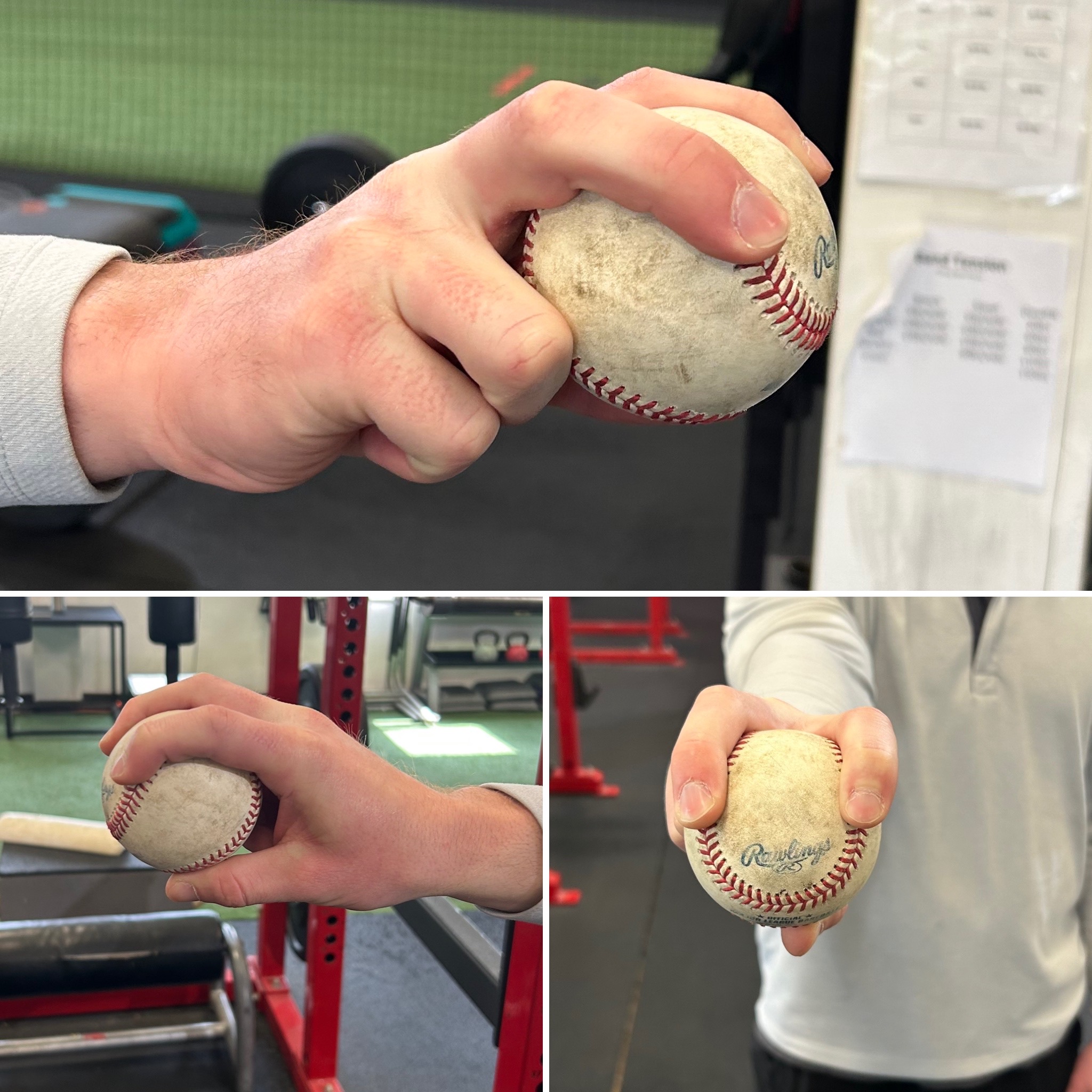
Split Changeup Grip
Cues to Help You Throw a Changeup
If you’re wondering how to throw a changeup, let’s start with this… throwing cues are NOT ONE SIZE FITS ALL!!
There are many different cues that people use when teaching pitchers how to throw each pitch. You need to find which cue best suits YOU and helps YOU throw your changeup more effectively. Some of the cues we use with our athletes are:
-
- “Throw the pointer finger first”
- “Middle finger and thumb pressure – throw it like a fastball”
- “Let the fingers come off the ball horizontally”
Tunneling Tips – When and Where to Throw a Changeup
The changeup that desires more “run”… is a great pitch to play off a 2SFB/Sinker. Both pitches try to limit the amount of vertical break the pitch has and maximize on the amount of horizontal break the pitch has to the pitcher’s arm side. Because both of these pitches move so similarly out of the pitcher’s hand, it will be very difficult for the hitter to pick up which one is being thrown. This will allow the differential in speed to fool the hitter and disrupt his timing.
The changeup that desires more “drop”… is a great pitch to play off a 4SFB. Both of these pitches will have similar movement and metrics. The only difference will be that the changeup should have less (+) vertical break and have a slower velocity. Because both of these pitches move so similarly out of the pitcher’s hand, it will be very difficult for the hitter to pick up which one is being thrown. This will allow the differential in speed and change in vertical break to fool the hitter and disrupt his timing.
Example of an Elite MLB Changeup
Devin Williams throws an ELITE changeup. This pitch nicknamed “the Airbender”, moves SIGNIFICANTLY different than any other change up in baseball. The average changeup in the MLB is thrown with 1750 RPM. Williams’ changeup is thrown at 2800 RPM, making it the highest spinning changeup in baseball.
In 2022, Williams threw his changeup 58% of the time (highest usage within his arsenal). The “Airbender” produced a .185 BA, .240 wOBA, 43.9% whiff %, and 24.8 K%. Although his changeup is an outlier pitch, he is still a great example to look at when trying to emulate ELITE changeup movement and execution.
By Jake Lebovitch (Pitching Coordinator, Strength Coach at RPP Baseball)
Articles in the How to Throw series:
You live too far to train with us in-house at RPP? You can now train with us on a REMOTE basis.


